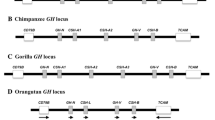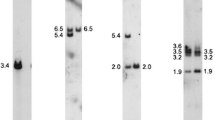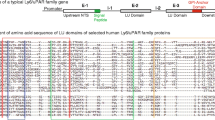Abstract
Mouse salivary androgen-binding protein (ABP) is a pair of dimers, composed of an alpha subunit disulfide bridged to either a beta or a gamma subunit. It has been proposed that each subunit is encoded by a distinct gene: Abpa, Abpb, and Abpg for the alpha, beta, and gamma subunits, respectively. We report here the structures and sequences of the genes that encode these three subunits. Each gene has three exons separated by two introns. Mouse salivary ABP is a member of the secretoglobin family, and we compare the structure of the three ABP subunit genes to those of 18 other mammalian secretoglobins. We map the three genes as a gene cluster located 10 cM from the centromere of Chromosome (Chr) 7 and show that Abpa is the closest of the three to the gene for glucose phosphate isomerase (GPI) and that Abpg is the closest to the centromere, with Abpb mapping between them. Abpa is oriented in the opposite direction to Abpb and Abpg, with its 5′ end directed toward their 5′ ends. We compare the location of these genes with other secretoglobin genes in the mouse genome and with the known locations of secretoglobin genes in the human genome and present evidence that strong positive selection has driven the divergence of the coding regions of Abpb and Abpg since the putative duplication event that created them.






Similar content being viewed by others
References
S Agarwal JP Viola A Rao (1999) ArticleTitleChromatin-based regulatory mechanisms governing cytokine gene transcription. J Allergy Clin Immunol 103 990–999 Occurrence Handle1:CAS:528:DyaK1MXktlSnurw%3D Occurrence Handle10359875
SF Altschul W Gish W Miller DE Myers DJ Lipman (1990) ArticleTitleBasic local alignment search tool. J Mol Biol 215 403–410 Occurrence Handle10.1006/jmbi.1990.9999 Occurrence Handle1:CAS:528:DyaK3MXitVGmsA%3D%3D Occurrence Handle2231712
I Callebaut A Poupon R Bally JP Demaret D Housset et al. (2000) ArticleTitleThe uteroglobin fold. Ann N Y Acad Sci 923 90–112 Occurrence Handle1:CAS:528:DC%2BD3MXnt1aqsQ%3D%3D Occurrence Handle11193783
M Choi Z Zhang LP Ten Kate JM Collee J Gerritsen et al. (2000) ArticleTitleHuman uteroglobin gene polymorphisms and genetic susceptibility to asthma. Ann N Y Acad Sci 923 303–306 Occurrence Handle1:CAS:528:DC%2BD3MXnt1ejug%3D%3D Occurrence Handle11193766
S Dlouhy R Karn (1983) ArticleTitleThe tissue source and cellular control of the apparent size of androgen binding protein (Abp), a mouse salivary protein whose electrophoretic mobility is under the control of Sex-limited saliva pattern (Ssp). Biochem Genet 21 1057–1070 Occurrence Handle1:CAS:528:DyaL2cXhtVSksLg%3D Occurrence Handle6686932
S Dlouhy R Karn (1984) ArticleTitleMultiple gene action determining a mouse salivary protein phenotype: identification of the structural gene for Androgen binding protein (Abp). Biochem Genet 22 657–667 Occurrence Handle1:CAS:528:DyaL2cXlvVyrtLw%3D Occurrence Handle6541906
R Dlouhy W Nichols R Karn (1986) ArticleTitleProduction of an antibody to mouse salivary androgen binding protein (ABP) and its use in identifying a prostate protein produced by a gene distinct from Abp. Biochem Genet 24 673–743
S Dlouhy B Taylor R Karn (1987) ArticleTitleThe genes for mouse salivary Androgen-binding protein (ABP) subunits alpha and gamma are located on chromosome 7. Genetics 115 535–543 Occurrence Handle1:CAS:528:DyaL2sXhvFSit7k%3D Occurrence Handle3569880
P Dominguez (1995) ArticleTitleCloning of a Syrian hamster cDNA related to sexual dimorphism: establishment of a new family of proteins. FEBS Lett 376 257–261 Occurrence Handle1:CAS:528:DyaK2MXhtVSgtr7M Occurrence Handle7498554
D Graur Li W-H (2000) Fundamentals of Molecular Evolution. Sinauer Associates, Inc. Sunderland, Mass
T Hubbard D Barker E Birney G Cameron Y Chen et al. (2002) ArticleTitleThe Ensembl genome database project. Nucleic Acids Res 30 38–41 Occurrence Handle1:STN:280:DC%2BD38%2FgsVehsA%3D%3D Occurrence Handle11752248
AL Hughes M Yeager (1997) ArticleTitleComparative evolutionary rates of introns and exons in murine rodents. J Mol Evol 45 125–130 Occurrence Handle1:CAS:528:DyaK2sXltFWgurY%3D Occurrence Handle9236271
J Hwang J Hoffstetter F Bonhomme R Karn (1997) ArticleTitleThe microevolution of mouse salivary androgen-binding protein (ABP) paralleled subspeciation of Mus musculus. J Hered 88 93–97 Occurrence Handle1:CAS:528:DyaK2sXislejsbw%3D Occurrence Handle9099004
R Karn M Clements (1999) ArticleTitleA comparison of the structures of the alpha:beta and alpha:gamma dimers of mouse salivary androgen-binding protein (ABP) and their differential steroid binding. Biochem Genet 37 187–199 Occurrence Handle1:CAS:528:DyaK1MXmslGju7c%3D Occurrence Handle10544804
R Karn C Laukaitis (2003) ArticleTitleCharacterization of two forms of mouse salivary androgen-binding protein (ABP): Implications for evolutionary relationships and ligand-binding function. Biochemistry 42 1192–1197
R Karn M Nachman (1999) ArticleTitleReduced nucleotide variability at an androgen-binding protein locus (Abpa) in house mice: evidence for positive natural selection. Mol Biol Evol 16 1192–1197 Occurrence Handle1:CAS:528:DyaK1MXmtVWntb0%3D Occurrence Handle10486974
R Karn R Russell (1993) ArticleTitleThe amino acid sequence of the alpha subunit of mouse salivary androgen-binding protein (ABP), with a comparison to the partial sequence of the beta subunit and to other ligand-binding proteins. Biochem Genet 31 307–319 Occurrence Handle1:CAS:528:DyaK2cXisFygsw%3D%3D Occurrence Handle8274137
R Karn A Orth F Bonhomme P Boarsot (2002) ArticleTitleThe complex history of a gene proposed to participate in a sexual isolation mechanism in house mice. Mol Biol Evol 19 462–471 Occurrence Handle1:CAS:528:DC%2BD38XivV2gtb4%3D Occurrence Handle11919288
D Karolchik R Baertsch M Diekhans TS Furey A Hinrichs et al. (2003) ArticleTitleThe UCSC genome browser database. Nucleic Acids Res 31 51–54 Occurrence Handle1:CAS:528:DC%2BD3sXhvFSgu7g%3D Occurrence Handle12519945
WJ Kent (2002) ArticleTitleBLAT–the BLAST-like alignment tool. Genome Res 12 656–664 Occurrence Handle1:CAS:528:DC%2BD38XivVemtLw%3D Occurrence Handle11932250
M Kimura (1983) The Neutral Theory of Molecular Evolution. Cambridge University Press Cambridge, U.K.
J Klug HM Beier A Bernard BS Chilton TP Fleming et al. (2000) ArticleTitleUteroglobin/Clara cell 10-kDa family of proteins: nomenclature committee report. Ann N Y Acad Sci 923 348–354 Occurrence Handle1:CAS:528:DC%2BD3MXnt1eitQ%3D%3D Occurrence Handle11193777
WS Klug MR Cummings (2003) Concepts of Genetics. Prentice Hall Upper Saddle River, NJ
E Kratz JC Dugas J Ngai (2002) ArticleTitleOdorant receptor gene regulation: implications from genomic organization. Trends Genet 18 29–34 Occurrence Handle1:CAS:528:DC%2BD3MXpt1agsr0%3D Occurrence Handle11750698
S Kumar K Tamura I Jakobsen M Nei (2001) ArticleTitleMega2: Molecular Evolutionary Genetics Analysis Software. Bioinformatics 17 1244–1245 Occurrence Handle1:CAS:528:DC%2BD38XmtVCktQ%3D%3D Occurrence Handle11751241
C Laukaitis E Critser R Karn (1997) ArticleTitleSalivary androgen-binding protein (ABP) mediates sexual isolation in Mus musculus. Evolution 51 2000–2005 Occurrence Handle1:CAS:528:DyaK1cXpvVSjsQ%3D%3D
RI Lehrer T Nguyen C Zhao CX Ha B Glasgow (2000) ArticleTitleSecretory lipophilins: a tale of two species. Ann N Y Acad Sci 923 59–67 Occurrence Handle1:CAS:528:DC%2BD3MXnt1aqsg%3D%3D Occurrence Handle11193779
E Menegatti A Nardacchione M Alpa C Agnes D Rossi et al. (2002) ArticleTitlePolymorphism of the uteroglobin gene in systemic lupus erythematosus and IgA nephropathy. Lab Invest 82 543–546 Occurrence Handle1:CAS:528:DC%2BD38Xks1Wksr8%3D Occurrence Handle12003994
Mukherjee A, Chilton B eds. (2000) The uteroglobin/Clara cell protein family. Ann N Y Acad Sci 923
I Narita N Saito S Goto S Jin K Omori et al. (2002) ArticleTitleRole of uteroglobin G38A polymorphism in the progression of IgA nephropathy in Japanese patients. Kidney Int 61 1853–1858 Occurrence Handle1:CAS:528:DC%2BD38XjvFWhs70%3D Occurrence Handle11967037
J Ni M Kalff-Suske R Gentz J Schageman M Beato et al. (2000) ArticleTitleAll human genes of the uteroglobin family are localized on chromosome 11q12.2 and form a dense cluster. Ann N Y Acad Sci 923 25–42 Occurrence Handle1:CAS:528:DC%2BD3MXnt1arug%3D%3D Occurrence Handle11193762
T Niimi CL Keck-Waggoner N Popescu Y Zhou B Levitt et al. (2001) ArticleTitleUGRP1, a uteroglobin/Clara cell secretory protein-related protein, is a novel lung-enriched downstream target gene for the T/EBP/NKX2.1 homeodomain transcription factor. Mol Endocrinol 15 2021–2036 Occurrence Handle1:CAS:528:DC%2BD3MXotFKjtrs%3D Occurrence Handle11682631
T Niimi M Munakata C Keck-Waggoner N Popescu B Levitt et al. (2002) ArticleTitleA polymorphism in the human UGRP1 gene promoter that regulates transcription is associated with an increased risk of asthma. Am J Hum Genet 70 718–725 Occurrence Handle1:CAS:528:DC%2BD38XislChtrw%3D Occurrence Handle11813133
NG Smith R Knight L Hurst (1999) ArticleTitleVertebrate genome evolution: a slow shuffle or a big bang?. Bioessays 21 697–703 Occurrence Handle1:STN:280:DyaK1MzmvFKgtw%3D%3D Occurrence Handle10440866
B Stripp S Reynolds C Plopper I Boe J Lund et al. (2000) ArticleTitlePulmonary phenotype of CCSP/UG deficient mice: a consequence of CCSP deficiency or altered Clara cell function?. Ann N Y Acad Sci 923 202–209 Occurrence Handle1:CAS:528:DC%2BD3MXisVagu7o%3D Occurrence Handle11193758
H Talley C Laukaitis R Karn (2001) ArticleTitleFemale preference for male saliva: implications for sexual isolation of Mus musculus subspecies. Evolution 55 631–634 Occurrence Handle1:CAS:528:DC%2BD3MXjsFSgt7c%3D Occurrence Handle11327170
R Waterston K Lindblad-Toh E Birney J Rogers J Abril et al. (2002) ArticleTitleInitial sequencing and comparative analysis of the mouse genome. Nature 420 520–562 Occurrence Handle10.1038/nature01262 Occurrence Handle12466850
R White (2001) Gene Transcription: Mechanisms and Control. Blackwell Science Ltd. London, U.K.
Z Zhang G Kundu F Zheng C Yuan E Lee et al. (2000) ArticleTitleInsight into the physiological function(s) of uteroglobin by gene-knockout and antisense-transgenic approaches. Ann N Y Acad Sci 923 210–233 Occurrence Handle1:CAS:528:DC%2BD3MXnt1ejsA%3D%3D Occurrence Handle11193759
Acknowledgements
The authors thank M. Nachman and R. Emes for helpful discussions and advice. This work was supported in part by the Holcomb Research Institute, Butler University, and that support is gratefully acknowledged.
Author information
Authors and Affiliations
Corresponding author
Rights and permissions
About this article
Cite this article
Laukaitis, C.M., Dlouhy, S.R. & Karn, R.C. The mouse salivary androgen-binding protein (ABP) gene cluster on Chromosomes 7: characterization and evolutionary relationships . Mamm Genome 14, 679–691 (2003). https://doi.org/10.1007/s00335-003-2291-y
Received:
Accepted:
Issue Date:
DOI: https://doi.org/10.1007/s00335-003-2291-y




